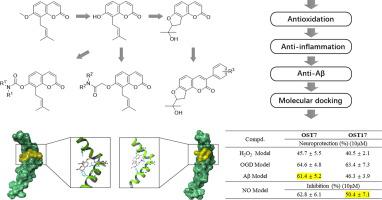Bioorganic & Medicinal Chemistry Letters ( IF 2.5 ) Pub Date : 2020-10-24 , DOI: 10.1016/j.bmcl.2020.127633 Li Zhang 1 , Yuhang Wu 1 , Guixiang Yang 1 , Haixian Gan 1 , Dayong Sang 2 , Jiye Zhou 1 , Lin Su 1 , Rui Wang 1 , Lei Ma 1

|
A total of 26 compounds based on osthole skeleton were designed, synthesized. Their cytoprotective abilities of antioxidation, anti-inflammation and Aβ42(Amyloid β-protein 42)-induced neurotoxicity were evaluated by MTT assays. Mechanism of the action of selected compounds were investigated by molecular docking. AlogP, logS and blood–brain barrier (BBB) permeability of all these compounds were simulated by admetSAR. Most of the compounds showed better antioxidative and anti-inflammatory activities compared with osthole, especially OST7 and OST17. The compound OST7 showed relative high activity in neuroprotection against H2O2 (45.7 ± 5.5%), oxygen glucose deprivation (64.6 ± 4.8%) and Aβ42 (61.4 ± 5.2%) at a low concentration of 10 μM. EC50 of selected compounds were measured in both H2O2 and OGD induced cytotoxicity models. Moreover, NO inhibiting ability of OST17(50.4 ± 7.1%) already surpassed the positive drug indomethacin. The structure activity relationship study indicated that introduction of piperazine group, tetrahydropyrrole group and aromatic amine group might be beneficial for enhancement of osthole neuroprotective properties. Molecular docking explained that the reason OST7 exhibited relatively stronger neuroprotection against Aβ because of the greater area of interactions between molecule and target protein. OST7 and OST17 both provided novel methods to investigate osthole as anti-AD drugs.
中文翻译:

设计,合成和生物学评估新型基于蛇窝蛋白的衍生物作为潜在的神经保护剂
总共设计,合成了基于臭虫骨架的26种化合物。通过MTT分析评估了它们的抗氧化,抗炎和Aβ42(淀粉样β蛋白42)诱导的神经毒性的细胞保护能力。通过分子对接研究了所选化合物的作用机理。所有这些化合物的AlogP,logS和血脑屏障(BBB)渗透性均通过admetSAR进行了模拟。与osthole相比,大多数化合物具有更好的抗氧化和抗炎活性,尤其是OST7和OST17。化合物OST7在针对H 2 O 2的神经保护中显示出较高的活性。(45.7±5.5%),低浓度10μM的氧葡萄糖剥夺(64.6±4.8%)和Aβ42(61.4±5.2%)。在H 2 O 2和OGD诱导的细胞毒性模型中都测量了所选化合物的EC 50。此外,OST17的NO抑制能力(50.4±7.1%)已经超过了吲哚美辛阳性药物。结构活性关系研究表明,引入哌嗪基,四氢吡咯基和芳香胺基可能有助于增强osthole神经保护特性。分子对接解释了OST7的原因由于分子和靶蛋白之间相互作用的区域更大,因此对Aβ的抗神经保护作用相对较强。OST7和OST17都提供了新颖的方法来研究osthole作为抗AD药物。











































 京公网安备 11010802027423号
京公网安备 11010802027423号